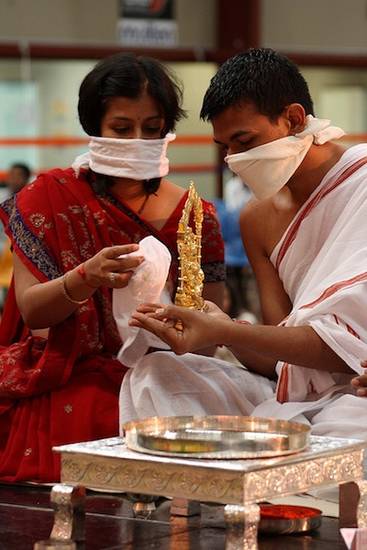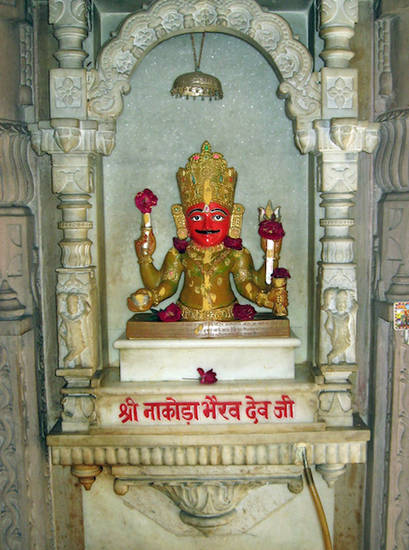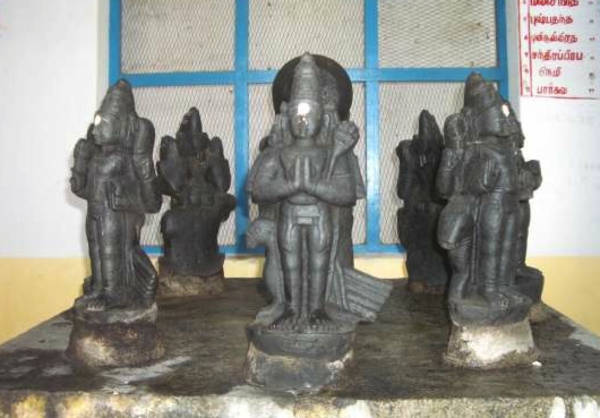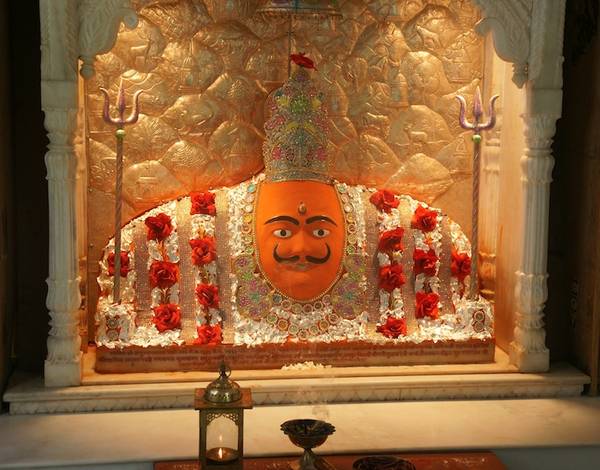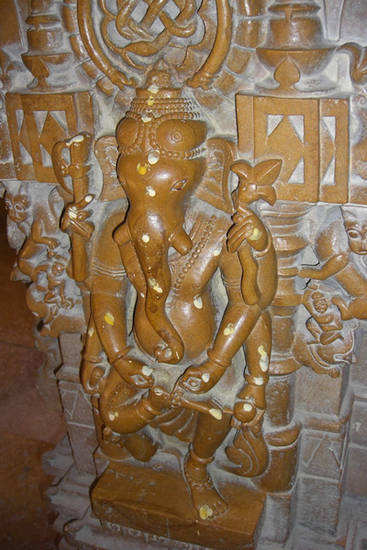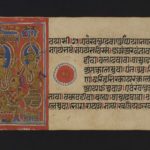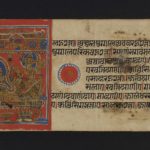Article: Deities
The Jains do not believe in gods or a god as creators of the world. The status of gods and goddesses among Jain followers is disputed. Some Jains do not worship deities but many Jains pay homage to gods and goddesses as mediators between the perfected souls of the Jinas and the imperfect world of human experience. Divine figures are very common in Jain temples and are frequently at the centre of religious rituals.
The focus of worship among Jains is the 24 Jinas. Believers respect and worship the Jinas, who are teachers and sources of the doctrine. The Jinas are fully liberated beings who have escaped the world of rebirths. They are perfect souls, who cannot, therefore, interact in any way with followers of the Jain religion. As unsurpassable models or ideals, they are beyond all possible requests coming from humans. They are thus totally different from gods, to whom worshippers pray to get various benefits.
The Jinas have reached the summit of the Jain universe – the siddha-śilā – and do not belong to any of the realms of the three worlds. In these kingdoms, however, lives a wide range of deities who are integrated into the system of Jain values to different extents. Living in allocated places in the Jain universe, the pantheon of Jain deities comprises various groups and some key individual figures. The divinities may have various roles and may be associated with concepts such as knowledge and worldly matters such as childbirth and wealth. Lesser gods are also worshipped in Jainism, who may be local divinities or sets of deities who represent or personify certain features or ideas.
Many of the major deities are known under the same names or different names in other Indian religious traditions. For example, Śrī or Lakṣmī is a major goddess for Hindus as well as Jains. Their Jain names may be identical to or in differing forms from those found in other Indian faiths. This does not necessarily mean that Jainism has ‘borrowed’ them. The origins of Jain gods and goddesses are complex and have to be specially investigated.
Although they may be members of groups of deities, some Jain divinities have personalities as individual figures and are worshipped as such. Associations with wealth or childbirth, for example, partly account for their popularity and they may be the focus of special religious rites.
Other Jain gods and goddesses are worshipped primarily as groups. There may not be much substantial difference among the individual members although each usually has divine attributes and a divine vehicle.
Evidence of the deities’ presence in iconography around images of the Jinas or as independent figures is growing, with investigations being carried out in regions which had previously been neglected, such as Bihar and Bengal or Tamil Nadu. In addition, recent examinations of sculptures, such as Mevissen, show that groups of deities, such as the guardians of directions – dik-pālas – and the nine planets – nava-grahas – are more common than scholars had so far thought.
Some gods are local deities connected with specific places, who may be worshipped only by people from that area. However, some have gained broader popularity in recent decades, such as Nākoḍā Bhairava, whose appeal has spread far and wide from his original home in Rajasthan.
All these deities may be part of Tantric modes of worship, where they are invoked and their statues or paintings placed on diagrams – yantras – for meditation (Jhavery 1944: 331, etc.).
Contested status
The sources of the Jain doctrine are the Jinas and the long route to liberation is an individual path. Gods and goddesses are part of the world of rebirths and are not self-controlled, instead demonstrating passions – kaṣāyas – as do human beings. Thus occasional voices deny that they have anything to do with the protection of Jain teaching and refuse their integration into the Jain system of values (Sethi n.d.). They consider them to be ‘popular’ or ‘folk’ deities, whose worship, if any, should be kept separate from ceremonies focused on the Jinas. Many image-worshipping Jains, however, pray to divinities as part of the general practice of their faith.
There have been heated debates within and between monastic orders in the Śvetāmbara sect as to whether the cults of these deities are justified in scripture. The issue includes whether hymns to the ‘deities of knowledge’ – śruta-devatās – and ‘guardian deities’ – kṣetra-devatās – should be part of the pratikramaṇa – the repentance ritual (Balbir 2003: 271–273).
For example, the Tapā-gaccha and the Kharatara-gaccha refer to the scriptural tradition, which, they say, teaches such worship and gives high credit to these deities. They quote examples of great monks whom deities helped. They assert that worshipping gods and goddesses helps to destroy the karma that keeps souls trapped in the cycle of birth, provided there is auspicious meditation. These sects consider these deities protect and help the teaching, deserve proper worship and are compatible with religious duties.
In the 13th century a new monastic order separated from the Pūrṇimā-gaccha after disagreements over the status of Jain deities. The new group took the name Tristutika-gaccha – ‘the three-hymned monastic order’ – or Āgama-gaccha – ‘the Scripture monastic order’ – because they rejected three homage formulas to Jain deities. Though they accepted the concept of praying to divinities, they held that ‘right believers’ should not accept such formulas. This subject still needs scholarly investigation.
Mendicants and deities
Śvetāmbara writings often link monks and nuns with deities in positive ways. Present-day mendicants are frequently active in promoting the worship of gods among lay followers, which is intended to complement worship of the Jinas, not to replace it.
There are several episodes which show that great Jain teachers – ācāryas – could play the role of māntrikas – knowers and practitioners of Tantric modes of worship – and could write Tantric works connected with Jain deities. Stories show that kings could call upon such teachers for help or rescue, asking them to use their powers in matters relating to the state or political power. Several teachers of the Kharatara-gaccha, an important Śvetāmbara monastic order found mostly in Rajasthan, are well known for their capacities in this area. Revered for having such abilities, they are known as the Dādā-gurus.
In modern times there is evidence that leading Jain mendicants are the primary movers in revivals or creations of cults to deities among local lay communities. These efforts are meant to deter Jain followers from worshipping non-Jain deities and to associate the quest for liberation with ways to satisfy worldly needs within the context of Jainism. Such instances are the cults of:
- Nākoḍā Bhairava
- Ghaṇṭākarṇa Mahāvīra
- Māṇibhadra Vīra
- more generally, yakṣas such as Brahmadeva or Padmāvatī, who have become independent gods and goddesses.
As part of contemporary worship, Jain deities are also popular among the diaspora.
Deities and the Jain universe
All the deities that make up the various groups of the Jain pantheon are supposed to live in one of the three worlds of the Jain universe, namely the:
- lower world – adho-loka
- middle world – madhya-loka
- upper world – ūrdhva-loka.
This is one way to group them (Jain and Fischer 1978). But there are also some categories that cut across this system, such as the dik-kumārīs.
Moreover, clan or family deities – kula-devatās – who are generally recognised and quite widespread, are not part of the Jain pantheon because they are local divinities who are not allocated places in the Jain universe.
|
Part of the Jain universe |
Group |
|---|---|
|
Lower world |
|
|
|
|
Upper world – lower levels |
|
Yakṣas and yakṣīs
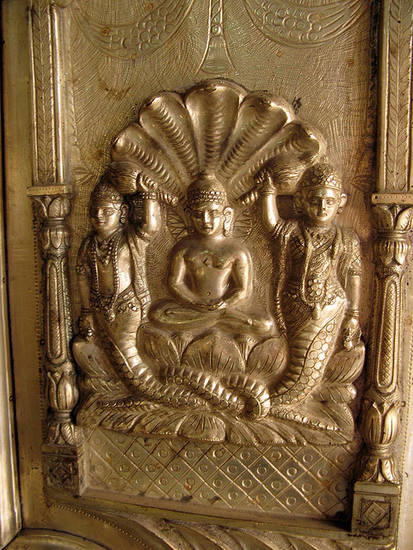
Pārśva attended by yakṣa and yakṣī
Image by Cactusbones – Sue Ann Harkey © CC Attribution-NonCommercial-ShareAlike 2.0
With complex origins, this group of divinities has come to be considered as the male and female attendant deities to the 24 Jinas. Living in the lower world, they have names and individual characteristics, such as vehicles and divine attributes, though these vary in the different Jain sects. They have special roles as protectors of the Jinas’ message and as intermediaries between devotees and the Jinas. Information on the yakṣas and yakṣīs is explored in a detailed article.
Some of the yakṣas and yakṣīs have developed cults of their own, which are celebrated either throughout India or chiefly in given regions. These are mainly the goddesses:
The only male yakṣa who can compare with them as an independent deity is Brahmadeva.
Dik-pālas
The Dik-pālas – ‘Guardians of Directions’ – form a category found in many Indian religions. There are eight or ten Jain Dik-pālas, depending on whether the deities of the upper and lower directions are included. The sect of the Digambaras does not include these deities, so there are always eight Digambara Dik-pālas.
These deities, who live in the lower world, serve the Jinas. The best known is Śakra, who intervenes at key points in the Jinas’ biographies.
There is a lot of variation in the attributes given to them in the available sources, namely ritual texts (Bhattacharya 1974: 109–116). Images of Dik-pālas depicted individually or in groups are carved on the outside walls or on the ceilings of temples in western India and Karnatak (Shah 1981 with plates). Recent research in eastern India has yielded interesting examples of Dik-pālas depicted as the entourage – parikara – of Jina images (Mevissen).
|
Dik-pāla |
Direction |
Summary |
|
|---|---|---|---|
|
1 |
Indra or Śakra |
east |
|
|
2 |
Agni |
south-east |
|
|
3 |
Yama |
south |
|
|
4 |
Nairr̥ta |
south-west |
|
|
5 |
Varuṇa |
west |
|
|
6 |
Vāyu |
north-west |
|
|
7 |
Kubera |
north |
|
|
8 |
Iśāna |
north-east |
|
|
9 |
upper regions |
||
|
10 |
Nāga |
lower world |
|
Nava-grahas
The Nava-grahas – ‘Nine Planets’ – are known in all the religious traditions that arose in India. They are part of the Jain universe as they form one of the classes of gods – the Jyotiṣka-devas.
As gods allotted homes in the lower world of Jain cosmology, they have been described in cosmological, iconographical and ritual texts. But descriptions of the Jyotiṣkas are not systematic in Śvetāmbara works and may be unavailable in Digambara sources. They are depicted as gods or humans in painting and sculpture.
|
English name |
Indian name |
Summary |
|---|---|---|
|
Sun |
Sūrya |
|
|
Moon |
Candra |
|
|
Mars |
Mangala |
|
|
Mercury |
Budha |
|
|
Jupiter |
Br̥haspati |
|
|
Venus |
Śukra |
|
|
Saturn |
Śani |
|
|
God who creates eclipses |
|
|
|
Comet |
|
Their presence is more collective than individual. Eastern Indian sculpture shows that some or all of them can be carved as the entourage – parikara – of Jina images, either as astral symbols or as figural representations (see Mevissen).
In Tamil Nadu, images of the nine planets are often depicted outside the main temple in a specific enclosure, where they may take non-human forms.
Vidyā-devīs
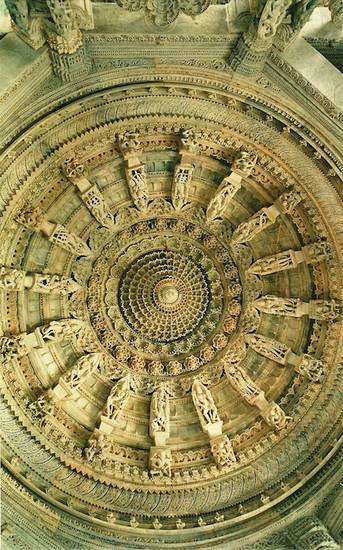
Ceiling of Lūṇa Vasahi
Image by olderock1 – Rakhee © CC BY-NC-ND 2.0
The Sanskrit word vidyā and its Prakrit counterpart vijjā refer to magic powers which can be obtained through meditation and ascetic practice. Of feminine gender, the term vidyā-devīs came to be used rather early only for 16 goddesses who personify individual magical qualities. The vidyā-devīs are said to live on the slopes of Mount Vaitāḍhya, in the middle world of the Jain universe.
The presence of vidyās is evidenced especially in two early Prakrit works which are likely to date back to the first six or seven centuries of the Common Era:
The Pauma-cariya is a Jain version of the Rāmāyaṇa epic poem, which was composed in Sanskrit. It lists the 16 classes of vidyās and explains their origins. The people who possess the vidyās are called vidyā-dharas and their kings are called Nami and Vinami. They gained their powers as the result of their worship of the first Jina, R̥ṣabhanātha or Lord R̥ṣabha. In this version of the Rāmāyaṇa, the monkeys – vānaras – and demons – rākṣasas – belong to lineages of vidyā-dharas.
The Vasudeva-hiṇḍī is a story work where the acquisition of vidyās plays an important role in the hero’s progress.
The notion of vidyās gradually develops into individual goddesses. They are then fixed as a group of 16, which is first available in Digambara sources, then later adopted in Śvetāmbara sources as well.
The individual vidyā-devīs vary but the best-known list is given in the table.
|
Number |
Name |
Approximate English meaning |
Appearance |
|---|---|---|---|
|
1 |
Rohiṇī |
she makes the seed of merit ‘grow’ up |
four-armed, six-armed, eight-armed, multi-armed forms |
|
2 |
Prajñapti |
she has wide knowledge and helps in shape changing |
two, four or multiple arms |
|
3 |
Vajra-śr̥ṅkhalā |
after her main attribute of a strong chain |
|
|
4 |
Vajrāṅkuśā |
after her attributes of the thunderbolt and goad |
|
|
5 |
Apraticakrā or Jambunadā |
|
|
|
6 |
Puruṣadattā |
origin of name unclear |
two, four or multiple arms |
|
7 |
Kālī |
after her dark complexion |
two, four or multiple arms |
|
8 |
Mahā-kālī |
‘very dark’ |
|
|
9 |
Gaurī |
‘of light complexion’ |
|
|
10 |
Gāndhārī |
no convincing explanation |
two, four or multiple arms |
|
11 |
Mahājvālā or Jvālāmālinī |
|
|
|
12 |
Mānavī |
name unclear |
|
|
13 |
Vairoṭī or Vairoṭyā |
for the removal of enmity, connected with snakes |
two, four or multiple arms |
|
14 |
Acyuptā, Acchuptā, Acyutā |
cannot be defiled by sins |
|
|
15 |
Mānasī |
‘born from the mind’ |
four arms |
|
16 |
Mahā-mānasī |
no convincing explanation of her name |
four or multiple arms |
Śvetāmbara and Digambara ritual or iconographic texts provide details about their iconography (Bhattacharya 1974: 124–132). However, representations of the individual vidyā-devīs are not common, especially among Digambaras.
Even so, there are some well-known carvings of the 16 vidyā-devīs as a group. The most famous ones are the group sculptures adorning:
- the ceiling of the dome in the main hall of the Vimala Vasahi, probably dating back to 1088 CE, when the original temple was constructed, which presents them standing with four arms each
- a corridor ceiling in front of cell number 41 of the Vimala Vasahi, showing them with six arms each
- the ceiling of the Lūṇa Vasahi at Mount Abu in Rajasthan, built by Tejaḥpāla in 1232 CE
- the outer wall of the shrine of the Kharatara Vasahi, also at Mount Abu, dating back to the 16th century, which displays a set of seated images and another of standing goddesses
- the domed ceiling of the temple at Ranakpur, in Rajasthan.
There are also possibly two vidyā-devīs and other goddesses in the Mahāvīra temple at Kumbharia,in Gujarat.
Vidyā-devīs are also occasionally represented in manuscripts, especially on palm leaf, usually with four arms (Shah 1947).
Dik-kumārīs
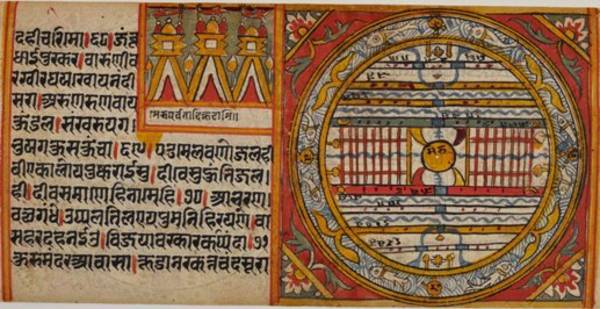
Mount Meru, Jambū-dvīpa and Lavaṇa-samudra
Image by British Library © CC0 1.0 (Creative Commons Public Domain)
The ‘Princesses of the Directions’ – dik-kumārīs – live on the different summits of Mount Meru and Rucaka-dvīpa in the middle world of the Jain universe. They act as attendants to the mother of a Jina, and have a very specific role in the ceremonies performed in honour of a newborn Jina.
They are listed and described in Śvetāmbara canonical works such as the Jambūdvīpa-prajñapti and the Kalpa-sūtra. Some Digambara texts also give the same role to dik-kumārīs.
There are 56 dik-kumārīs, distributed into two categories of 32 and 24. There are eight deities for the four quarters of the Rucaka mountains, who are known from Jain and Buddhist sources (Alsdorf). Śvetāmbara texts also detail 24 additional goddesses, but disagree over where they live and come from.
Hemacandra’s version (Triṣaṣṭiśalākāpuruṣacarita, Johnson’s translation, volume I: 105–107) has become the standard Śvetāmbara list, and states there are:
- eight dik-kumārīs living in the lower world
- eight living in the upper world
- eight living on the eastern Rucaka mountains, on the Rucaka continent
- eight living on the southern Rucaka mountains
- eight living on the western Rucaka mountains
- eight living on the northern Rucaka mountains
- four living on the Rucaka mountains at the intermediate points of the compass
- four living on the Rucaka continent.
Dik-kumārīs are occasionally shown in Kalpa-sūtra miniature paintings depicting the Jinas’ birth celebrations. It is uncertain whether a set of female figures shown in two circular rows at the Vimala Vasahi temple on Mount Abu in Rajasthan represent this group of deities (northern Paṭṭaśālā, bhāva number 37 in front of cell number 47; Shah 1982: 281). They carry pitchers, fly-whisks and so on, which may be associated with religious ceremonies.
Goddesses of the lakes
These are six goddesses who live on islands in the middle of the six lakes – hrada – located on the six ranges of mountains which divide the Jambū-dvīpa in the middle world. They are personifications of feminine concepts.
|
Name of goddess |
Lake |
Mountain range |
|---|---|---|
|
Śrī – ‘prosperity’ |
Padma |
Himavant |
|
Hrī – ‘sense of shame’ |
Mahāpadma |
Mahā-himavant |
|
Dhṛti – ‘patience’ |
Tigiñcha |
Niṣadha |
|
Kīrti – ‘glory’ |
Kesarī |
Nīla |
|
Buddhi – ‘intelligence’ |
Mahāpuṇḍarīka |
Rukmin |
|
Lakṣmī – ‘prosperity’ |
Puṇḍarīka |
Śikharin |
They are often called mahā-devīs – ‘great goddesses’ – and their names are often mentioned in Tantric modes of worship and other contexts. Representations are rare or difficult to identify.
Śakra and other indras
The Sanskrit word indra is used as a noun for the king of a group of gods. Śvetāmbaras admit a total of 64 indras (Shah 1984).
|
Classes of gods |
Number of groups |
Number of indras |
|---|---|---|
|
Bhavanavāsin |
10 |
2 indras for each group = 20 |
|
8 |
2 indras for each group = 16 |
|
|
Vāṇa-Vyantara |
8 |
2 indras for each group = 16 |
|
distributed over the 12 heavens |
12 indras |
These divinities live in the upper world of the Jain universe, in the kalpas or heavens. The most famous is Śakra, the lord of the gods who reside in the Saudharma, the lowest of the 12 kalpas in the upper world.
Śakra intervenes at key points in the lives of the Jinas, as shown in both the Kalpa-sūtra text and miniature paintings in manuscripts of the work. He is usually portrayed sitting on a lion throne in his court, depicted with four arms and holding a thunderbolt – vajra. His vehicle is the elephant Airāvata. JAINpedia provides numerous examples of digitised manuscripts with illustrations of Śakra, with notable examples including:
- a depiction of him sitting on his throne in his court in the Saudharma heaven and another portrayal of the same subject
- getting up from his throne to praise Mahāvīra’s embryo
The story of the previous birth of his mount Airāvata is also illustrated.
Figures of Śakra’s commander-in-chief Hariṇaigameṣin may be replacements of vidyā-devīs – goddesses of magical knowledge – in sculpture, like here in the Mahāvīra temple at Kumbharia, Gujarat.
Another indra of importance is Īśāna, lord of the second kalpa, the Aiśāna.
The indras are described among classes of gods in cosmological manuscripts, with details of their attributes, identifying animals and so on. They are commonly carved on temple walls and painted on paper manuscripts or cloth paintings of the yantra type.
Hariṇaigameṣin
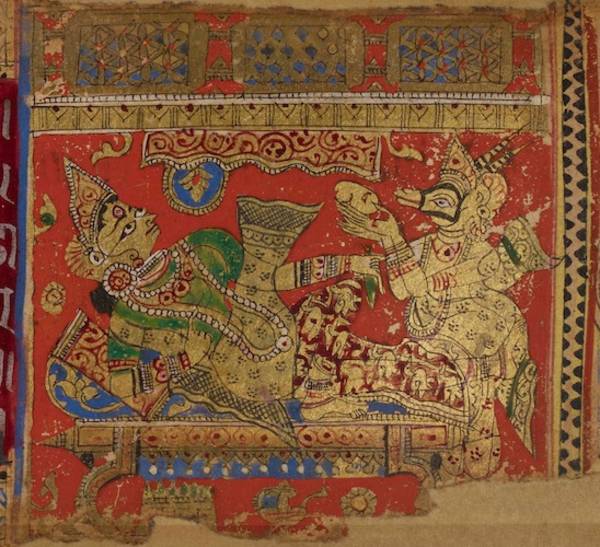
Hariṇaigameṣin removes the embryo
Image by British Library © CC0 1.0 (Creative Commons Public Domain)
This deity is mainly known among Śvetāmbaras, as the god who performs the embryo transfer of the 24th Jina, Mahāvira, and he is thus associated with pregnancy and childbirth.
As Śvetāmbara Jains narrate in the Kalpa-sūtra text, Hariṇaigameṣin is the commander-in-chief of Śakra. The divine king orders Hariṇaigameṣin to transfer Mahāvira’s embryo from the womb of the Brahmin lady Devānandā to that of Queen Triśalā.
Hariṇaigameṣin is familiar to Śvetāmbaras from his depiction in manuscript paintings of the scripture called the Kalpa-sūtra. Some examples on JAINpedia are:
- Hariṇaigameṣin waiting for Śakra’s orders
- Śakra and Hariṇaigameṣin depicted in popular style in this Kalpa-sūtra manuscript with a Gujarati commentary.
His name means ‘antelope-headed’ and the standard representation of Hariṇaigameṣin is of a male figure with the head of an antelope, ram or goat. The oldest image comes from the early site of Mathurā, in Uttar Pradesh.
Hariṇaigameṣin seems to have been regarded as a god who can grant the boon of pregnancy and he is worshipped to this effect. The Jain version of the story of Kr̥ṣṇa found in the Antagaḍa-dasāo, the eighth Aṅga of the Śvetāmbara canonical scriptures, shows how the childless woman Sulasā worshipped him. She had an image made of Hariṇaigameṣin, to which she performed rites every day, and revered him. In compassion for her, Hariṇaigameṣin caused her to become pregnant. When it happened that her children were born dead, the god carried them to Devakī and brought her living children to Sulasā for her to care for instead (Barnett 1907: 67).
Sarasvatī
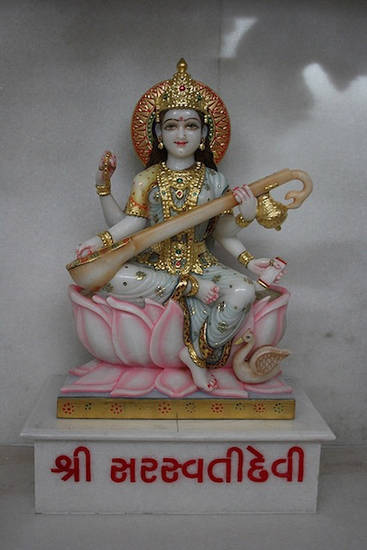
Sarasvatī
Image by hedonia – Ruchi © CC BY-NC-ND 2.0
Jains call the goddess of speech and knowledge Sarasvatī, which is also her name among Hindus. She is also known as:
- Śruta-devatā – ‘the divinity of learning’
- Śruta-devī – ‘goddess of knowledge’
- Vāg-īśvarī – ‘the goddess of speech’
- Śāradā.
Sarasvatī lives in the lower levels of the upper world of the Jain universe, where gods and goddesses live. She is very popular and is honoured by writers in particular. In addition, worship of Sarasvatī is one of the key parts of the annual festivals of knowledge.
Sarasvatī’s antiquity in the Jain tradition is supported by references in early texts, including some of the Śvetāmbara canonical scriptures.
Numerous statues of Sarasvatī are available. The oldest is a headless image dated 132 CE from the Kankāli Tila site at Mathurā, in modern Uttar Pradesh. One of the most famous Sarasvatī images is the marble figure in Rajasthan, dating from the 12th century and known as ‘Bikaner or Pallu Sarasvatī’, which is kept in the National Museum, New Delhi.
The main identifying characteristics of Sarasvatī in iconography are:
- her divine vehicle – vāhana – of a swan or peacock, the latter mainly in Digambara sources
- attributes of a manuscript or book, and a lotus
- the presence of a lute – vīṇā.
Painted images of Sarasvatī are often found in manuscripts. Writers who wish for a well-received work frequently pay homage to Sarasvatī in her capacity as the goddess of speech at the beginning or end of their manuscripts.
Several of the manuscripts digitised on JAINpedia show instances of this, such as:
- the four-armed image of Sarasvatī on a swan and holding a manuscript, lute and lotus, found at the end of a manuscript of the Līlāvatī, a mathematical treatise
- the painting of Sarasvatī on a swan and holding a manuscript and lute at the beginning of a manuscript of a commentary on Hemacandra’s 12th-century Sanskrit thesaurus, the Abhidhāna-cintāmaṇi
- the depiction of Sarasvatī riding a swan at the start of the Śrīpāla-rāsa, a very popular Śvetāmbara story
- the image of Sarasvatī sitting on a swan inside a temple at the beginning of a manuscript of the Ādityavāra-vrata-kathā, a popular story among Digambara circles.
Sarasvatī is worshipped especially at the yearly Jain festivals connected with knowledge and teaching:
- the Śruta-pañcamī among the Digambaras
- the Śvetāmbara Jñana-pañcamī.
The Tantric mode of worship characteristic of the worship of yakṣīs such as Padmāvatī and Jvālāmālinī can also be used to honour Sarasvatī. Rituals implying meditation on mantras and yantras, and propitiatory rites are described in kalpa texts such as Malliṣeṇa-sūri’s Sarasvatī-mantra-kalpa and Bappabhaṭṭi’s Sarasvatī-kalpa (Nawab 1937/1996: 151–166 and Jhavery 1944: 316–320). The mantra hrīṃ-kāra is particularly connected with Sarasvatī.
Śrī or Lakṣmī
Śrī, who resides in the lake at the top of Mount Himavant, is also the Jain goddess of wealth and prosperity. She is also known as Lakṣmī, more rarely Padmā or Ramā. She has the same names among Hindus. In the Jain universe she lives in the lower levels of the upper world, the home of gods and goddesses.
She is specially worshipped by lay Jains, among whom business is one of the main occupations, on the day known as Dhana-terasa – ‘Wealth Thirteenth’ – before the festival of Dīvālī. This is done through a pūjā that ‘involves sprinkling auspicious red powder and pañcāmr̥t or ‘five nectars’ of milk, curd, clarified butter, honey, and sugar onto silver coins’ (Cort 2001: 164).
Śrī or Lakṣmī is found in early sources, as she features among the 14 or 16 dreams announcing the birth of a future Jina, which the mother experiences while pregnant. As such, she is painted on manuscript pages or embroidered on cloth manuscript covers, and usually appears in larger size than the other dreams. Among items digitised on JAINpedia, noteworthy examples are:
- Kalpa-sūtra manuscripts, for instance this page depicting the Śvetāmbara dreams
- two manuscript covers, IS 20-1978 and IS 50-1983
- a vijñapti-patra or invitation scroll that shows the goddess under a pink canopy.
Kṣetra-pālas
This generic designation refers to deities who are considered ‘guardians of land or territory’. This means either a large area or, more narrowly, the temple precincts. They live in the lower levels of the upper world of the Jain universe.
There are three main classes of kṣetra-pāla gods among Jains:
- yoginīs
- bhairavas
- vīras.
As protective deities, the kṣetra-pālas are fierce and can be aggressive so devotees may placate them in religious ceremonies. They also have the power to grant wishes if worshipped correctly.
When kṣetra-pālas are shown in Jain temples, they are found mainly at the sides of doors, as if to protect the entrance.
Yoginīs
The yoginīs form a category familiar in other Indian religions. Thought of as guardians of land or territory, the 64 yoginīs are mostly seen as terrifying and therefore need to be pacified. Thus they appear in Tantric modes of worship and are invoked, with their images placed on yantras or maṇḍalas in various stotras (see for instance Nawab 1937/1996: 186 and Jhavery 1944: 333–335).
The available lists show variations in the names of the yoginīs. They feature in a number of Jain writings, which portray them as malevolent deities who can take possession of human beings. Texts from the 12th century relate how famous Jain teachers performed rites to free people from their evil influence.
In one example, Hemacandra is said to have persuaded the goddess Saindhava-devī at Broach or Bharuch in Gujarat to order the yoginīs to quit the minister Ambaḍa. He had fallen ill due to their influence (Jhavery 1944: 220).
In another case, Jinadatta-sūri is said to have won control over the yoginīs and other groups of deities as well (Jhavery 1944: 214).
According to another anecdote, the 64 yoginīs took over the 64 towers around the new Ahmedabad fort. Harassed by the deities, Sultan Ahmed Shah sought aid from the Jain teacher Ratnasiṃha-sūri, who was able to help him by using a mystical diagram.
Bhairavas
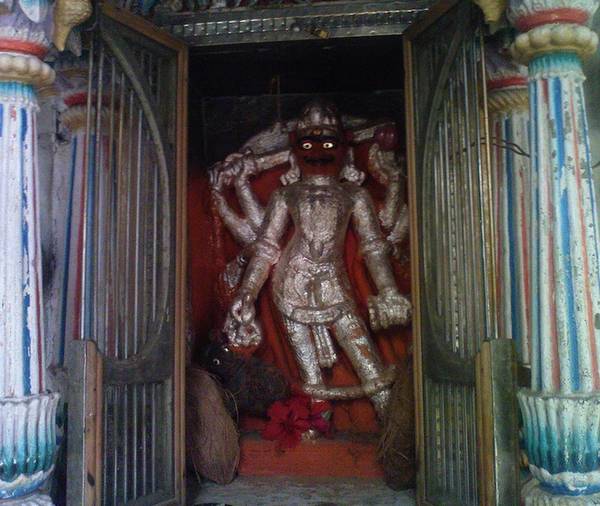
Bhairava
Image by Anirudh Bhatti © CC BY-SA 2.0
The bhairavas are male deities who protect temple precincts. They are depicted as aggressive warriors, reflecting the name bhairava, which means ‘frightening, terrible’. They are originally local deities, very common in Rajasthan for instance. They are associated with the Hindu god Śiva, especially as Bhairava is also the proper name of one of Śiva’s terrifying forms. Some of the bhairavas, such as Nākoḍa Bhairava, have been thoroughly integrated into the Jain fold.
Images of a bhairava riding a dog are fairly common on the sides of the doors of Jain temples as both the god and the animal are regarded as guardian figures.
Vīras
Another category of guardian deities are the vīras – ‘heroes, warriors’. Traditionally there are 52 of them but only two have assumed prominent roles.
Ghaṇṭākarṇa Mahāvīra

Ghaṇṭākarṇa Mahāvīra
Image by Romana Klee © CC BY-SA 2.0
A deity who has gained growing importance in Śvetāmbara Jainism since the early 20th century is Ghaṇṭākarṇa Mahāvīra. Images of this solid mustachioed male figure, ready to shoot an arrow fixed on the bow he carries, are increasingly seen in Jain temples.
Ācārya Buddhi-sāgara-sūri (1874–1925) established the cult, with its main centre at Mahudi, near Vijapur in Gujarat, and made it a largely public phenomenon (Cort 2000, 2001). Thousands of devotees visit this place, which has become extremely popular, especially on the day before Dīvālī. They offer a special sweet dish known as sukhaḍī to Ghaṇṭākarṇa, both to thank him and to ‘insure that any possible malevolent influences from the previous year are negated’ (Cort 2000: 419). His cult implies making offerings to fire, a normal procedure in Hindu worship.
Ghaṇṭākarṇa’s mantra is:
Oṃ Ghaṇṭākarṇa Mahāvīra! Destroyer of all ailments! Protect protect those in mighty fear of boils, Greatly Strong!
Wherever you stand, O deity, diseases and gout are destroyed by the written lines of letters.
Instantly from the recitation in the ear there is no fear of kings. Witches, ghosts, vampires, and demons do not arise.
There is no untimely death, nor are snakes seen, nor is there fear of fire or thieves, hrīṃ Ghaṇṭākarṇa! Homage to you ṭhaḥ ṭhaḥ ṭhaḥ svāhā
Translation by Cort 2001, page 166
The mantra, however, ends with the phrase ‘Show the path to liberation by the gift of pure knowledge’. This discreetly underlines that worldly benefits are not the only ones requested. For details and translations, see pages 420 to 433 of Cort 2000.
Māṇibhadra Vīra
Sitting on an elephant that is often shown with three trunks, this boar-headed being with four or more hands has become a familiar sight on side doors or niches in Śvetāmbara temples. He is worshipped only among Tapā-gaccha followers, and is the presiding deity of this monastic order.
Legendary accounts of Māṇibhadra Vīra stress his fighting character and role in defending both image worship and the Tapā-gaccha monastic lineage. For example, he is described as the reincarnation of a 16th-century lay man who defended image-worshipping practice against the followers of Loṅkā Śāh. In his subsequent birth he was a hero who defeated a bhairava who had been invoked by opponents of the Tapā-gaccha (Wiley 2004: 138).
According to another version (Shah 1982: 97):
Māṇek, a lay Jain follower of the Tapāgaccha, hailing from a place called Magarvāḍa, heroically fought against the supernatural obstruction of yoginīs created by monks of the Kharatara-gaccha, while he was on his way to Shatrunjaya and died. He was born as a demi-god, a Vīra. He then protected his fellow brethren of the Tapāgaccha and gradually overcame the other party.
There are Śvetāmbara shrines specifically dedicated to him at Magarvada and Aglor in north Gujarat, and at Ujjain in Madhya Pradesh.
Gaṇeśa
The well-known elephant-headed, pot-bellied god of the Hindus is also a Jain god. Associated with wealth, arts and sciences, knowledge and wisdom, Gaṇeśa is very popular among Jains.
He never features as the main deity in a Jain temple, but it is quite common to see Gaṇeśa depicted either on the outside walls of western Indian temples or in cells at the entrance or sides.
Worship of this god may be a part of Jain worship during ceremonies (Cort 2001: 168).
Kula-devatās
The term kula-devatā or its synonym kula-devī means ‘clan or family deities’. These local deities are mainly goddesses, regarded as protective mothers – mātās. They are not part of what may be called the Jain pantheon, since they are not given places in the Jain universe, but are elements in the lives of many Jains.
Worshipping kula-devatās is considered compatible with being a Jain, and most families regularly travel to their original villages to perform worship at ancestral shrines. There are examples of goddesses, such as Sācikā-devī at Osian, Rajasthan, who have been included in the Jain fold. It is quite possible that many of the local deities Jains recognise were originally village gods and goddesses who had nothing to do with Jain values.
Links
- Kubera the yakṣa
-
This 2011 photograph on Flickr shows a large sculpture of the yakṣa Kubera. He is the male attendant deity of the 19th Jina, Malli. As with many of the Jinas' guardian gods, Kubera is often worshipped, because he can intervene in human affairs.
http://www.flickr.com/photos/spaceman-nishant-spiff/6760999341/
- Kālaka and Śakra
-
The Śvetāmbara monk Kālaka and the king of the gods, Śakra, discuss Jain doctrine. The National Gallery of Australia provides this highly decorated page from a 15th-century manuscript of the Kālakācāryakathā.
http://artsearch.nga.gov.au/Detail-LRG.cfm?IRN=3131&View=LRG
- Nava-grahas and Dik-pālas sculptures
-
Professor Gerd Mevissen discusses examples of carvings of two groups of Jain deities:
- Nava-grahas – 'Nine Planets'
- Dik-pālas – 'Guardians of Directions'.
This presentation, entitled 'North Bengal (Ancient Varendra): An Innovative Sub-Centre Of Jaina Sculptural Art', was delivered at the tenth Jaina Studies Workshop, on the theme of Jaina Art and Architecture at SOAS on 7 March 2008. Information is provided by the HereNow4U website.
- Figure of a vidyā-devī
-
An 11th-century carving of one of the 16 vidyā-devīs – goddesses of magical knowledge – held at the British Museum in London.
- Vidyā-devīs at Ranakpur
-
The 16 vidyā-devīs – goddesses of magical knowledge – are the largest figurative sculptures on the intricately carved domed ceiling of the temple at Ranakpur in Rajasthan. Click on the black-and-white photograph provided by the Digital South Asia Library at the University of Chicago in the USA to see the sculpture in more detail.
http://dsal.uchicago.edu/images/aiis/aiis_search.html?depth=Get+Details&id=30475
- Ceiling at Ranakpur
-
The ornate domed ceiling of the main hall – maṇḍapa – of the Ādinātha temple at Ranakpur in Rajasthan. The large figures are the goddesses of magical knowledge – vidyā-devīs – while small sculptures of sitting Jinas are arranged in rows around the concentric circles of the dome. The Digital South Asia Library at the University of Chicago in the USA provides this black-and-white photograph.
http://dsal.uchicago.edu/images/aiis/aiis_search.html?depth=Get+Details&id=30509
- R̥ṣabha and Indra
-
A manuscript painting in the Los Angeles County Museum of Art shows Indra, king of the gods, taking the infant R̥ṣabhanātha or Lord R̥ṣabha, the first Jina, to Mount Meru for his ritual bath. The decorated elephant and canopy symbolise royalty while the lotus flowers are emblems of spiritual purity. The gods around blow trumpets and conches in celebration. A very popular Jain hymn of praise, the Bhaktāmara-stotra has been translated into many languages and illustrated numerous times.
- Mahāvīra renounces
-
This illustration is from a page of the Śvetāmbara scripture of the Kalpa-sūtra in the collections of the Philadelphia Museum of Art. It shows the last Jina, Mahāvīra, performing the rite of keśa-loca – ‘pulling out of the hair’ – which indicates indifference to the body. It is part of the initiation ceremony of dīkṣā, in which an initiate renounces the world and becomes a mendicant. He is watched by Śakra, king of the gods, who takes an active role in the lives of the 24 Jinas.
http://www.philamuseum.org/collections/permanent/105108.html?mulR=656|9
- A Jina renounces
-
This highly decorated page from a 15th-century manuscript of the Kalpa-sūtra is provided by the National Gallery of Australia. A young man performs the rite of keśa-loca – ‘pulling out of the hair’ – which indicates indifference to the body. It is part of the initiation ceremony of dīkṣā, in which an initiate renounces the world and becomes a mendicant. He is watched by Śakra, king of the gods who takes an active role in the lives of the 24 Jinas.
http://artsearch.nga.gov.au/Detail-LRG.cfm?IRN=177852&View=LRG
- Hariṇaigameṣin transfers the embryo
-
This rare palm-leaf page in the collections of the Philadelphia Museum of Art comes from an early 14th-century manuscript of the Śvetāmbara scripture of the Kalpa-sūtra. The picture illustrates the episode where the antelope-headed god Hariṇaigameṣin transfers the embryo of the Jina-to-be Mahāvīra from the brahmin lady Devānandā to the kṣatriya queen Triśalā.
http://www.philamuseum.org/collections/permanent/131608.html?mulR=656|4
- Nākoḍā Bhairava
-
The Nakoda Bhairav website provides information about the Śvetāmbara temple at Nakoda, Rajasthan but focuses on presenting hymns, pictures and songs celebrating the Śvetāmbara protective deity Nākoḍā Bhairava. Website visitors can read and listen to hymns and download them, along with pictures of Nākoḍā Bhairava's statue. There is also an e-book in Hindi to read online or download.
- Nākoḍā Bhairava in California
-
Facebook provides a picture of an idol of the Śvetāmbara protective god Nākoḍā Bhairava housed in the Jain Center of Northern California, in Milpitas, California.
- Ghaṇṭākarṇa Mahāvīra
-
Idol of Ghaṇṭākarṇa Mahāvīra in the Jain temple in Leicester, England, provided by Flickr. He is instantly recognisable from his characteristic pose of readying his arrow to shoot, and is increasingly popular among Śvetāmbara Jains.
- Māṇibhadra Vīra
-
This Śvetāmbara deity can be identified from his boar head and mount of an elephant, which often has three trunks, as this one does. Māṇibhadra Vīra is the presiding deity of the Tapā-gaccha sect and is worshipped only by Tapā-gaccha followers. This photograph is provided on Flickr.
- Hymn to Māṇibhadra
-
This 2012 video on YouTube video shows images of the Śvetāmbara deity Māṇibhadra Vīra while a Sanskrit stuti – hymn – dedicated to him is played. He is the protective deity of the Tapā-gaccha sect.
- Māṇibhadra Vīra worship in Toronto, 2011
-
This 2011 YouTube video shows scenes from the worship ceremony to the protective deity Māṇibhadra Vīra in Toronto, Canada. This warrior deity sits on an elephant, often shown with three trunks, in Śvetāmbara Tapā-gaccha temples. Māṇibhadra Vīra has the head of a boar and four or more hands. He is worshipped only among Tapā-gaccha followers, as the presiding deity of this monastic lineage.
- Shrine to Gaṇeśa
-
A portable Jain shrine to the popular deity Gaṇeśa. With an elephant head, Gaṇeśa is associated with wealth, knowledge of all kinds and wisdom. Details of this shrine are provided by Christie's of London, where it was auctioned in 2009.
- +
- aAbhavya
- aAbhinandana
- aAbhiṣeka
- aĀcāra
- aĀcārāṅga-sūtra
- aĀcārya
- aAchalbhrata
- aAḍhāī-dvīpa
- aAdharma
- aAdho-loka
- aAdhyayana
- aAdvaita Vedānta
- aĀgama
- aAghātīya
- aAghātīya-karman
- aAgnibhuti
- aAgra
- aĀhāra
- aAhiṃsā
- aAhimsa Day
- aAjita
- aAjīva
- aAkampit
- aĀkāśa
- aAkbar the Great
- aAkṣaya-tṛtīyā
- aAlauddin Khalji
- aAlbert Einstein
- aAllah
- aAlms
- aĀlocanā
- aAloka-ākāśa
- aAmāri
- aAmbikā or Kūṣmāṇḍinī
- aAnagāra
- aAnanta
- aAnarthadaṇḍa
- aAnaśana
- aAnekānta-vāda
- aAṅga
- aAniconism
- aAnojjā
- aAntarāla
- aAntarāya-karma
- aAṇu
- aAṇu-vrata
- aAnukampā
- aAnuprekṣā
- aAnusvāra
- aApabhraṃśa
- aAparigraha
- aAra
- aĀrambha
- aĀrambhaja
- aĀratī
- aArdhamāgadhī Prākrit
- aArhaṃ
- aArhat
- aArśana-āvaraṇīya-karma
- aĀrta-dhyāna
- aĀryikā
- aĀryikā Jñānamati
- aĀśātanā
- aĀścarya
- aAscetic
- aAsceticism
- aAshram
- aAspiration
- aĀsrava
- aAṣṭa-maṅgala
- aAṣṭāpada
- aAstikāya
- aAstrolabe
- aAsura
- aAtheism
- aAticāra
- aAtiśayakṣetra
- aAtithisaṃvibhāgavrata
- aĀtma-vāda
- aĀtman
- aAuṃ
- aAurangzeb
- aAuspicious
- aAusterity
- aAvadhāna
- aAvadhi-jñāna
- aĀvaraṇī-yakarman
- aAvasarpiṇī
- aAvatāra
- aAvidyā
- aAxiom
- aĀyāga-paṭa
- aĀyambil
- aĀyu-karma
- aĀyurveda
- bBabur
- bBāhubali
- bBaladeva
- bBālāvabodha
- bBandha
- bBasadi
- bBazaar
- bBhadrankarvijay
- bBhagavant
- bBhaktāmara-stotra
- bBhakti
- bBhale
- bBharata
- bBhāṣā
- bBhāṣya
- bBhaṭṭāraka
- bBhāva
- bBhāva-pūjā
- bBhāvanā
- bBhavana-vāsin
- bBhavya
- bBhavyatva
- bBhaya
- bBhoga-bhūmi
- bBhogopabhoga
- bBodhi
- bBollywood
- bBrahmā
- bBrahma-deva
- bBrahmacārī
- bBrāhmaṇa
- bBraj Bhāṣā
- bBright fortnight
- bBritish Raj
- bBuddha
- bBuddhi-sagar
- bBuddhism
- bBuddhist
- cCaitya
- cCaityavāsin
- cCakravartin
- cCakreśvarī
- cCāmara
- cCandanā
- cCandragupta
- cCandraprabha
- cCanon
- cCāritra
- cCāritramohanīya-karman
- cCarũrī
- cCaste
- cCaturvidha-saṅgha
- cCaturviṃśati-stava
- cCāturyāma
- cCE
- cCelibacy
- cCha
- cChadmastha
- cChastity
- cCheda-sūtra
- cChristian
- cChristianity
- cClergy
- cCloning
- cColophon
- cCommentary
- cConch
- cConfession
- cCongregation
- cConsecration
- cCosmology
- cCremation
- cCrore
- cCult
- cCūrṇi
- dDādā-guru
- dDalit
- dDāna
- dDaṇḍa
- dDark fortnight
- dDarśana
- dDarśanamohanī-yakarman
- dDaśa-lakṣaṇa-parvan
- dDeity
- dDelhi Sultanate
- dDerāsar
- dDeśāvakāśika-vrata
- dDetachment
- dDevanāgarī
- dDevānandā
- dDevarddhi-gani
- dDevotee
- dDhamal
- dDhanuṣ
- dDhāra
- dDharma
- dDharma-dhyāna
- dDharma-sāgara
- dDharmastikaya
- dDhātakīkhaṇḍa
- dDholak
- dDhyāna
- dDiaspora
- dDig-vrata
- dDigambara
- dDīkṣā
- dDisciple
- dDīvālī
- dDivya-dhvani
- dDNA
- dDoctrine
- dDogma
- dDonor
- dDoṣa
- dDravya
- dDravya-pūjā
- dDrone
- dDuṣamā
- dDuṣamā-duṣamā
- dDuṣamā-suṣamā
- dDveṣa
- dDvīpa
- eEast India Company
- eEightfold Path
- eEkānta-vāda
- eEkendriya
- eElder
- eElders
- eEschatology
- eEtc up to
- fFarmān
- fFast
- fFatehpur Sikri
- fFestival
- fFestschrift
- fFiruz Shah
- fFly-Whisks
- fFolio
- fFour Noble Truths
- gGaccha
- gGaṇa
- gGaṇadhara
- gGanadharavada
- gGaṇeśa
- gGaṇin
- gGarba
- gGarbha
- gGarbha-gṛha
- gGaruḍa
- gGati
- gGene
- gGenomics
- gGhātī-yakarman
- gGhātīya
- gGhaznavid
- gGhiyasuddin Tughlaq
- gGhurid
- gGloss
- gGotra-karma
- gGujarāt
- gGujarati
- gGuṇa
- gGuṇa-sthāna
- gGuṇa-vrata
- gGupti
- gGuru
- gGuruṇī
- hHagiography
- hHajj
- hHaṃsa
- hHaribhadra
- hHariṇaigameṣin
- hHasta
- hHeresy
- hHiṃsā
- hHindi
- hHindu
- hHinduism
- hHīravijaya
- hHoroscope
- hHrīṃ
- hHumayun
- hHymn
- iIconoclasm
- iIconography
- iIdol
- iIndian Independence
- iIndology
- iIndra
- iIndrabhūti Gautama
- iIndriya
- iInitiation
- iIntercession
- iInvocation
- iIQ
- iIslam
- iIslamicate
- iIṣṭadevatā
- iĪśvara
- jJagat
- jJahangir
- jJain
- jJaina Devanāgarī
- jJaina Śaurasenī
- jJaina-dharma
- jJainaśāsana
- jJainness
- jJaisalmer
- jJamāli
- jJambū-dvīpa
- jJames Burgess
- jJanma
- jJanma-kalyāṇa
- jJarā
- jJāti
- jJina
- jJina-āgama
- jJina-bhavana
- jJina-bimba
- jJina-mātā
- jJinacandra-sūri
- jJinadatta
- jJinaprabha
- jJīva
- jJñāna
- jJñāna-āvaraṇīya-karma
- jJñāna-āvarṇiya
- jJñānsundar
- jJyotiṣka
- kKāla
- kKālakācārya-kathā
- kKālidāsa
- kKalpa-sūtra
- kKalpa-vṛkṣa
- kKalyāṇaka
- kKalyanvijay
- kKamaṇḍalu
- kKamaṭha
- kKarma
- kKarma-bhūmi
- kKarma-grantha
- kKarma-prakṛti
- kKarma-vāda
- kKarmon
- kKarnataka
- kKaṣāya
- kKathā
- kKāvya
- kKāya
- kKāyotsarga
- kKeśa-loca
- kKetu
- kKevala-jñāna
- kKevalin
- kKhalji
- kKharatara-gaccha
- kKnowledge
- kKriyā
- kKriyā-vāda
- kKṛṣṇa
- kKṣamā-śramaṇa
- kKṣapakaśreṇi
- kKṣatriya
- kKṣullaka
- kKulakara
- kKundakunda
- kKunthu
- lLabdhi
- lLaity
- lLakh
- lLāñchana
- lLands of Action
- lLaukāntika
- lLavaṇa-samudra
- lLeśyā
- lLiṅga
- lLinguistics
- lLoka
- lLoka-ākāśa
- lLoka-puruṣa
- lLoka-vāda
- lLotus
- lLotus lake
- mMadhya-loka
- mMahā-videha
- mMahā-vrata
- mMahābhārata
- mMahāmastakābhiṣeka
- mMāhārāṣṭra
- mMāhārāṣṭrī Prākrit
- mMahattarā Yākinī
- mMahāvīr Jayantī
- mMahāvīra
- mMakāra
- mMakkhali Gośāla
- mMalli
- mMāna-stambha
- mManaḥ-paryāya-jñāna
- mMaṇḍala
- mMaṇḍapa
- mMandit
- mMaṅgala
- mMantra
- mMantras
- mManuṣya-loka
- mMarāṭhī
- mMārgaṇā
- mMartyr
- mMarudevī
- mMaṭha
- mMati-jñāna
- mMauryaputra
- mMecca
- mMendicant lineage
- mMetarya
- mMiracle
- mMithyādṛṣṭi
- mMohandas Gandhi
- mMohanīya-karma
- mMokṣa
- mMonastic order
- mMonasticism
- mMonk
- mMonotheism
- mMosque
- mMount Meru
- mMount Sammeta
- mMṛgāvatī
- mMughal
- mMuhammad
- mMuhammad bin Tughlaq
- mMuhpattī
- mMūla-sūtra
- mMūlaguṇa
- mMumbaī
- mMuni
- mMunisuvrata
- mMurad Bakhsh
- mMūrti-pūjaka
- mMuslim
- mMysticism
- nNābhi
- nNāga-kal
- nNāgapurīya Tapā-gaccha
- nNāgarī
- nNāma-karma
- nNamaskāra-mantra
- nNami
- nNandīśvara-dvīpa
- nNandivardhana
- nNandyāvarta
- nNāraka
- nNāraki
- nNasalisation
- nNātha
- nNavrātrī
- nNaya-vāda
- nNemi
- nNidāna
- nniggaṃthāṇa vā 2
- nniggaṃtho vā 2
- nNigoda
- nNihnava
- nNikṣepa
- nNirgrantha
- nNirjarā
- nNirvāṇa
- nNiryukti
- nNiṣidhi
- nNitya
- nNiyati
- nNo-kaṣāya
- nNudity
- nNun
- oOcean of milk
- oOmniscience
- oOrdination
- ppa°
- pPadmaprabha
- pPadmāsana
- pPadmāvatī
- pPādukā
- pPalanquin
- pPalette
- pPañca-muṣṭi
- pPāṇḍava
- pPaṇḍit
- pPandit Dalsukh D. Malvania
- pPandit Sukhlalji
- pPāṇipātra
- pPāpa
- pParamātman
- pParameṣṭhin
- pPāraṇā
- pParigraha
- pPariṇāma
- pParīṣaha
- pParokṣa
- pPārśva
- pPārśvanātha
- pParyāya
- pParyuṣaṇ
- pPaṭa
- pPatan
- pPātra
- pPenance
- pPersian
- pPhala
- pPhilology
- pPicchikā
- pPilgrimage
- pPīr
- pPolymath
- pPoṣadha
- pPossession
- pPothī
- pPrabhas
- pPradakṣiṇā
- pPradeśa
- pPrākāra
- pPrakīrṇaka-sūtra
- pPrākrit
- pPramāda
- pPramukhā
- pPrati-vāsudeva
- pPratikramaṇa
- pPratimā
- pPratiṣṭhā
- pPratyākhyāna
- pPratyakṣa
- pPravacana
- pPrāyaścitta
- pPrayer
- pPre-modern
- pPreach
- pPredestination
- pProtestant
- pProvenance
- pPudgala
- pPūjā
- pPujārī
- pPukharavara-dvīpa
- pPuṇya
- pPūrva
- pPuṣkara-dvīpa
- pPuṣpadanta
- pPyre
- qQur’an
- rRāga
- rRāhu
- rRainy season
- rRajasthan
- rRajasthani
- rRājimatī
- rRajoharaṇa
- rRajput
- rRāma
- rRāmāyaṇa
- rRangoli
- rRās-garbā
- rRasa
- rRathanemi
- rRatna-traya
- rRātri-bhojana
- rRaudra-dhyāna
- rRecto
- rRelic
- rRenunciation
- rRetroflex
- rRevatī
- %Ṛg-veda
- rRite
- rRosary
- %Ṛṣabha
- %Ṛṣabhanātha
- rRupee
- sSaciyā Mātā
- sSādhu
- sSādhvī
- sSāgāra
- sSaint
- sŚaivaism
- sŚaka-saṃvat
- sSallekhanā
- sŚalya
- sSamacatuṣṭha
- sSamādhimaraṇa
- sSamaṇi
- sSāmarambha
- sSamavasaraṇa
- sSāmāyika
- sSaṃbhava
- sSamiti
- sSaṃjñā
- sSaṃkalpaja
- sSaṃsāra
- sSamudghāta
- sSaṃvara
- sSaṃvega
- sSamyak-cāritra
- sSamyak-darśana
- sSamyak-jñāna
- sSamyaktva
- sSaṃyama
- sSanctuary
- sSandalwood
- sSaṇgha
- sSanskrit
- sSant
- sŚānti
- sSapta-bhaṅgi-naya
- sSārambha
- sSarasvatī
- sSarvajña
- sSāsan-devi
- sŚāsana-devatā
- sŚāstra
- %Ṣaṭ-jīvanikāya
- sSatī
- sSatīmātā
- sSatya
- sSchism
- sScribe
- sScripture
- sSect
- sSecularism
- sŚenāī
- sSermon
- sŚeṣavatī
- sSevā
- sSeven fields of donation
- sShah Jahan
- sShantidas Jhaveri
- sShrine
- sSiddha
- sSiddha-śilā
- sSiddhacakra or Navadevatā
- sSiddhānta
- sSiddhārtha
- sSiddhi
- sSikh
- sSikhism
- sŚikṣā-vrata
- sŚīla
- sSin
- sSindh
- sŚītala
- sŚiva
- sSkandha
- sSomanatha
- sŚraddhā
- sŚramaṇa
- sŚrāvaka
- sŚrāvakācāra
- sŚrāvikā
- sŚreyāṃsa
- sŚrī
- sŚrīvatsa
- sŚruta-jñāna
- sŚruta-pañcamī
- sSthānaka-vāsin
- sSthāpanācārya
- sSthāvara
- sSthavira
- sSthiti
- sStrīmukti
- sStūpa
- sSubcontinent
- sSudarshana
- sŚuddhi
- sSudharma
- sŚūdra
- sSufism
- sSukha
- sŚukla-dhyāna
- sSulasā
- sSultan
- sSumati
- sSundarśrī
- sSupārśva
- sSūri
- sSuṣamā
- sSuṣamā-duṣamā
- sSuṣamā-suṣamā
- sSūtra
- sSuyam me ausam! Tenam bhagavaya evamakkhayam
- sSvādhyāya
- sSvāhā
- sSvastika
- sŚvetāmbara
- sŚvetāmbara Terāpanthin
- sŚvetāmbaras
- sSwan
- sSyād-vāda
- tTabla
- tTantra
- tTapā-gaccha
- tTapas
- tTāraṇ Svāmī Panth
- tTattva
- tTattvārtha-sūtra
- tTemple
- tTemple-city
- tThe Enlightenment
- tTheology
- tThree worlds
- %Ṭīkā
- tTilaka
- tTīrtha
- tTīrthaṃkaranāma-karman
- tTīrthankara
- tTransliteration
- tTrasa
- tTrasa-nāḍī
- tTriśalā
- tTriṣaṣṭi-śalākā-puruṣa-caritra
- tTti bemi
- tTughlaq
- tTunk
- uUdumbara
- uUniversal History
- uUpādhyāya
- uUpāṅga
- uUpaniṣads
- uUpāsaka
- uUpasarga
- uUpāśraya
- uŪrdhva-loka
- uUtsarpiṇī
- uUttarādhyayana-sūtra
- vVāhana
- vVaimānika
- vVairāgya
- vVaiṣṇava
- vVaiśramaṇa
- vVaiśya
- vValabhī
- vVanaspatikāya
- vVandana
- vVaṇik
- vVarṇa
- vVāsudeva
- vVāsupūjya
- vVayubhūti
- vVeda
- vVedanīya-karma
- vVegetarianism
- vVehicle
- vVernacular
- vVerso
- vVidyā
- vVidyā-devī
- vVihāra
- vVijñapti-patra
- vVikrama-saṃvat
- vVikṛti
- vVimala
- vVinaya
- vVipāka
- vVirji Vora
- vVirodhaja
- vVīrya
- vVisarga
- vViṣṇu
- vVītarāga
- vVizier
- vVotive
- vVow
- vVrata
- vVS
- vVyakta
- vVyantara
- vVyasana
- yYakṣa
- yYakṣī
- yYantra
- yYaśoda
- yYaśovijaya
- yYati
- yYātrā
- yYoga
- yYoginī
- yYojana


